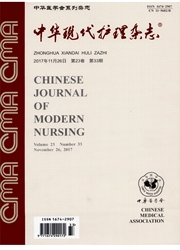

 中文摘要:
中文摘要:
目的:比较红外耳温计和水银体温计在放疗患者中测得的体温差异,并分析性别对这一差异的影响。方法分别采用红外耳温计和水银体温计,测量得到348组耳温和腋温,用SPSS软件分析比较不同性别的耳、腋温温差,评估0.5℃温差经验值在放疗患者中的适用性。结果348组体温数据显示腋温与耳温温差值平均为(0.19±0.41)℃,耳温高于腋温,差异有统计学意义(t=8.52,P〈0.01,95%CI:0.14~0.23),且与经验值(0.5℃)有出入并具有统计学意义(P〈0.05)。两组性别的温差数据使用独立样本t检验进行分析比对,男性组温差的平均值为(0.15±0.38)℃,女性组温差的平均值为(0.25±0.45)℃,方差齐性检查的结果是F=4.435,P=0.036,性别不同的两组温差数据的均值差异具有统计学意义(t=2.133,P=0.034),差异均值为(0.10±0.05)℃,95%CI为0.008~0.196℃。结论红外耳温计使用安全且操作简单方便,但在与传统腋温测量结果转换比较时应注意性别和个体差异。
 英文摘要:
英文摘要:
Objective To compare the temperatures of radiotherapy patients measured with electronic ear thermometer and axillary mercury thermometer, and investigate the impact of gender on the differences of the ear and axillary temperatures. Methods A total of 348 pairs of ears and axillary temperatures were acquired, and the differences between ear and axillary temperatures were calculated. SPSS software was utilized to analyze the differences and the applicability of the empirical conversion factor of 0. 5 Celsius degree among radiotherapy patients. Results Significantly higher temperature was observed at the ear than the axillary [ mean difference=(0.19 ± 0. 41)℃], (t =8. 52, P 〈0. 01, 95%CI: 0. 14 -0. 23), and the difference was statistically inconsistent with the empirical conversion factor of 0. 5 (P 〈0. 05). Using the independent sample t test, Levene′s test for equality of variances indicated that the mean value of male was (0. 15 ± 0. 38)℃, female (0.25 ±0.45)℃ (F=4. 435,P=0. 036). The temperature difference of ear and axillary were significantly gender-dependent [t=2. 133, P=0. 034, mean difference=(0. 10 ± 0. 05)℃, 95%CI:0. 008-0. 196℃]. Conclusions Ear thermometer is safe and convenient, yet the conversion to traditional axillary temperature should be handled with attention especially considering the gender and individual varieties.
 同期刊论文项目
同期刊论文项目
 同项目期刊论文
同项目期刊论文
 Variationsof circulating endothelial progenitor cells and transforming growth factor-beta-1(TGF-beta
Variationsof circulating endothelial progenitor cells and transforming growth factor-beta-1(TGF-beta Sulforaphane reverses chemo-resistance to temozolomidein glioblastoma cells by NF-κB-dependent pathw
Sulforaphane reverses chemo-resistance to temozolomidein glioblastoma cells by NF-κB-dependent pathw 期刊信息
期刊信息
